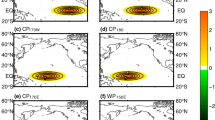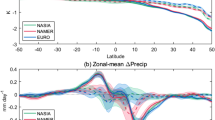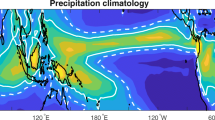Abstract
Arguments based on atmospheric energetics and aqua-planet model simulations link the latitudinal position of the intertropical convergence zone (ITCZ) to atmospheric cross-equatorial energy transport—a greater southward transport corresponds to a more northerly position of the ITCZ. This idea is often invoked to explain an interhemispheric dipole pattern of precipitation anomalies in paleoclimates. In contrast, here we demonstrate that in the tropical Pacific the response of the fully coupled ocean-atmosphere system to a hemispherically asymmetric thermal forcing, modulating this energy transport, involves an interplay between the ITCZ and its counterpart in the South Pacific—the Southern Pacific convergence zone (SPCZ). This interplay leads to interhemispheric seesaw changes in tropical precipitation, such that the latitudinal position of each rain band remains largely fixed, but their intensities follow a robust inverse relationship. The seesaw behavior is also evident in the past and future coupled climate simulations of the Climate Model Intercomparison Project Phase 5 (CMIP5). We also show that the tropical Pacific precipitation response to thermal forcing is qualitatively different between the aqua-planet (without ocean heat transport), slab-ocean (with climatological ocean heat transport represented by a “Q-flux”) and fully-coupled model configurations. Specifically, the induced changes in the ITCZ latitudinal position successively decrease, while the seesaw precipitation intensity response becomes more prominent, from the aqua-planet to the slab-ocean to the fully-coupled configuration. Thus, the ITCZ/SPCZ seesaw can explain the paleoclimate precipitation dipole pattern without invoking a too strong climate forcing and is relevant to future projections of tropical precipitation.









Similar content being viewed by others
References
Abiodun BJ, Gutowski WJ, Prusa JM (2008) Implementation of a non-hydrostatic, adaptive-grid dynamics core in CAM3. Part II: dynamical influences on ITCZ behavior and tropical precipitation. Climate Dyn 31(7–8):811–822
Adam O, Bischoff T, Schneider T (2016a) Seasonal and interannual variations of the energy flux equator and ITCZ. Part I: zonally averaged ITCZ position. J Climate 29(9):3219–3230
Adam O, Bischoff T, Schneider T (2016b) Seasonal and interannual variations of the energy flux equator and ITCZ. Part II: zonally varying shifts of the ITCZ. J Climate 29(20):7281–7293
Adler RF, Huffman GJ, Chang A, Ferraro R, Xie PP, Janowiak J, Rudolf B, Schneider U, Curtis S, Bolvin D et al (2003) The version-2 global precipitation climatology project (GPCP) monthly precipitation analysis (1979–present). J Hydrometeorol 4(6):1147–1167
Arbuszewski JA, Cléroux C, Bradtmiller L, Mix A et al (2013) Meridional shifts of the atlantic intertropical convergence zone since the last glacial maximum. Nat Geosci 6(11):959–962
Barreiro M, Fedorov A, Pacanowski R, Philander SG (2008) Abrupt climate changes: how freshening of the northern Atlantic affects the thermohaline and wind-driven oceanic circulations. Annu Rev Earth Planet Sci 36:33–58
Bischoff T, Schneider T (2014) Energetic constraints on the position of the intertropical convergence zone. J Climate 27(13):4937–4951
Broccoli AJ, Dahl KA, Stouffer RJ (2006) Response of the ITCZ to northern hemisphere cooling. Geophys Res Lett 33(1):L01702. https://doi.org/10.1029/2005GL024546
Burls N, Fedorov A (2014a) Simulating pliocene warmth and a permanent el niño-like state: the role of cloud albedo. Paleoceanography 29(10):893–910
Burls N, Fedorov A (2014b) What controls the mean east–west sea surface temperature gradient in the equatorial Pacific: the role of cloud albedo. J Climate 27(7):2757–2778
Burls NJ, Fedorov AV (2017) Wetter subtropics in a warmer world: contrasting past and future hydrological cycles. Proc Natl Acad Sci 114(49):12888–12893
Chiang JC, Bitz CM (2005) Influence of high latitude ice cover on the marine intertropical convergence zone. Climate Dyn 25(5):477–496
Chiang JC, Friedman AR (2012) Extratropical cooling, interhemispheric thermal gradients, and tropical climate change. Annu Rev Earth Planet Sci 40:383–412
Chiang JC, Cheng W, Bitz CM (2008) Fast teleconnections to the tropical Atlantic sector from Atlantic thermohaline adjustment. Geophys Res Lett 35(7):L07704. https://doi.org/10.1029/2008GL033292
Deser C, Tomas RA, Sun L (2015) The role of ocean-atmosphere coupling in the zonal-mean atmospheric response to Arctic sea ice loss. J Climate 28(6):2168–2186
DiNezio P, Clement A, Vecchi G, Soden B, Broccoli A, Otto-Bliesner B, Braconnot P (2011) The response of the walker circulation to last glacial maximum forcing: implications for detection in proxies. Paleoceanogr Paleoclimatol 26(3)
Donohoe A, Marshall J, Ferreira D, Mcgee D (2013) The relationship between ITCZ location and cross-equatorial atmospheric heat transport: from the seasonal cycle to the last glacial maximum. J Climate 26(11):3597–3618
Fiedler PC, Talley LD (2006) Hydrography of the eastern tropical pacific: a review. Prog Oceanogr 69(2–4):143–180
Frierson DM, Hwang YT (2012) Extratropical influence on ITCZ shifts in slab ocean simulations of global warming. J Climate 25(2):720–733
Frierson DM, Hwang YT, Fučkar NS, Seager R, Kang SM, Donohoe A, Maroon EA, Liu X, Battisti DS (2013) Contribution of ocean overturning circulation to tropical rainfall peak in the northern hemisphere. Nat Geosci 6(11):940–944
Green B, Marshall J (2017) Coupling of trade winds with ocean circulation damps ITCZ shifts. J Climate 30(12):4395–4411
Haug GH, Hughen KA, Sigman DM, Peterson LC, Röhl U (2001) Southward migration of the intertropical convergence zone through the holocene. Science 293(5533):1304–1308
Hawcroft M, Haywood JM, Collins M, Jones A, Jones AC, Stephens G (2017) Southern ocean albedo, inter-hemispheric energy transports and the double ITCZ: global impacts of biases in a coupled model. Climate Dyn 48(7–8):2279–2295
Hu S, Fedorov AV (2018) Cross-equatorial winds control el niño diversity and change. Nat Climate Change 8(9):798
Hurrell JW, Holland MM, Gent PR, Ghan S, Kay JE, Kushner PJ, Lamarque JF, Large WG, Lawrence D, Lindsay K et al (2013) The community earth system model: a framework for collaborative research. Bull Am Meteorol Soci 94(9):1339–1360
Kang SM, Held IM, Frierson DM, Zhao M (2008) The response of the ITCZ to extratropical thermal forcing: idealized slab-ocean experiments with a GCM. J Climate 21(14):3521–3532
Kang SM, Frierson DM, Held IM (2009) The tropical response to extratropical thermal forcing in an idealized GCM: the importance of radiative feedbacks and convective parameterization. J Atmos Sci 66(9):2812–2827
Kay JE, Wall C, Yettella V, Medeiros B, Hannay C, Caldwell P, Bitz C (2016) Global climate impacts of fixing the southern ocean shortwave radiation bias in the community earth system model (CESM). J Climate 29(12):4617–4636
Koutavas A, Lynch-Stieglitz J (2004) Variability of the marine ITCZ over the eastern pacific during the past 30,000 years. The Hadley circulation: present, past and future. Springer, Dordrecht, pp 347–369
Landu K, Leung LR, Hagos S, Vinoj V, Rauscher SA, Ringler T, Taylor M (2014) The dependence of ITCZ structure on model resolution and dynamical core in aquaplanet simulations. J Climate 27(6):2375–2385
Li G, Xie SP (2014) Tropical biases in CMIP5 multimodel ensemble: the excessive equatorial pacific cold tongue and double ITCZ problems. J Climate 27(4):1765–1780
Lin JL (2007) The double-ITCZ problem in IPCC AR4 coupled GCMS: ocean-atmosphere feedback analysis. J Climate 20(18):4497–4525
Liu Z, Vavrus S, He F, Wen N, Zhong Y (2005) Rethinking tropical ocean response to global warming: the enhanced equatorial warming. J Climate 18(22):4684–4700
Liu Y, Guo L, Wu G, Wang Z (2010) Sensitivity of ITCZ configuration to cumulus convective parameterizations on an aqua planet. Climate Dyn 34(2–3):223–240
Marshall J, Donohoe A, Ferreira D, McGee D (2014) The ocean’s role in setting the mean position of the inter-tropical convergence zone. Climate Dyn 42(7–8):1967–1979
Matthews AJ (2012) A multiscale framework for the origin and variability of the south pacific convergence zone. Q J R Meteorol Soc 138(666):1165–1178
Neale RB, Hoskins BJ (2000) A standard test for AGCMS including their physical parametrizations. II: results for the met office model. Atmos Sci Lett 1(2):108–114
Oueslati B, Bellon G (2013) Tropical precipitation regimes and mechanisms of regime transitions: contrasting two aquaplanet general circulation models. Climate Dyn 40(9–10):2345–2358
Rotstayn LD, Lohmann U (2002) Tropical rainfall trends and the indirect aerosol effect. J Climate 15(15):2103–2116
Schneider T (2017) Feedback of atmosphere-ocean coupling on shifts of the intertropical convergence zone. Geophys Res Lett 44(22):11644–11653. https://doi.org/10.1002/2017GL075817
Schneider T, Bischoff T, Haug GH (2014) Migrations and dynamics of the intertropical convergence zone. Nature 513(7516):45
Song F, Zhang GJ (2016) Effects of southeastern Pacific sea surface temperature on the double-ITCZ bias in NCAR CESM1. J Climate 29(20):7417–7433
Tomas RA, Deser C, Sun L (2016) The role of ocean heat transport in the global climate response to projected Arctic sea ice loss. J Climate 29(19):6841–6859
Van Der Wiel K, Matthews AJ, Joshi MM, Stevens DP (2016) Why the south Pacific convergence zone is diagonal. Climate Dyn 46(5–6):1683–1698
Waliser DE, Gautier C (1993) A satellite-derived climatology of the ITCZ. J Climate 6(11):2162–2174
Williamson DL, Olson JG (2003) Dependence of aqua-planet simulations on time step. Q J R Meteorol Soc J Atmos Sci Appl Meteorol Phys Oceanogr 129(591):2049–2064
Xiang B, Zhao M, Ming Y, Yu W, Kang SM (2018) Contrasting impacts of radiative forcing in the southern ocean versus southern tropics on ITCZ position and energy transport in one GFDL climate model. J Climate 31(14):5609–5628
Xie P, Arkin PA (1997) Global precipitation: a 17-year monthly analysis based on gauge observations, satellite estimates, and numerical model outputs. Bull Am Meteorol Soc 78(11):2539–2558
Xie SP, Philander SGH (1994) A coupled ocean-atmosphere model of relevance to the ITCZ in the eastern Pacific. Tellus A 46(4):340–350
Yoshimori M, Broccoli AJ (2008) Equilibrium response of an atmosphere-mixed layer ocean model to different radiative forcing agents: global and zonal mean response. J Climate 21(17):4399–4423
Zhang R, Delworth TL (2005) Simulated tropical response to a substantial weakening of the Atlantic thermohaline circulation. J Climate 18(12):1853–1860
Zhang H, Clement A, Medeiros B (2016) The meridional mode in an idealized aquaplanet model: dependence on the mean state. J Climate 29(8):2889–2905
Acknowledgements
This research was supported by Grants to A.V.F. from the NSF (AGS-0163807), NASA (NNX17AH21G) and ANR (ANR-18-MPGA-0001, France), and by the Guggenheim Fellowship. B.Z. was supported by a NASA Earth and Space Sciences Graduate Fellowship. We also acknowledge computational support from the Yale University Faculty of Arts and Sciences High Performance Computing facility, and from the NASA High-End Computing (HEC) Program through the NASA Center for Climate Simulation (NCCS) at Goddard Space Flight Center. We also thank the referees for many helpful comments.
Author information
Authors and Affiliations
Corresponding author
Additional information
Publisher's Note
Springer Nature remains neutral with regard to jurisdictional claims in published maps and institutional affiliations.
Electronic supplementary material
Below is the link to the electronic supplementary material.
Rights and permissions
About this article
Cite this article
Zhao, B., Fedorov, A. The seesaw response of the intertropical and South Pacific convergence zones to hemispherically asymmetric thermal forcing. Clim Dyn 54, 1639–1653 (2020). https://doi.org/10.1007/s00382-019-05076-6
Received:
Accepted:
Published:
Issue Date:
DOI: https://doi.org/10.1007/s00382-019-05076-6




